Modules in the 2.4 GHz band vs 920 MHz band
In addition to the 2.4 GHz band, the 920 MHz band was newly assigned as the ISM Band on July 25 2012 and the use of the new band in Japan was started. The ISM Band stands for the Industrial, Scientific and Medical Band and it can be used for these purposes in the assigned frequency band without license. The ISM Band has been used for WiFi, Bluetooth equipment, cordless phones, radio controls, and so on.
We explain the features of the 920 MHz band wireless and the 2.4 GHz band wireless used for sensor network here.
The 920 MHz band wireless for sensor network has been drawing people’s attention, because the 900 MHz band has been advertised under the name of Platinum Band by cell-phone carriers. However, as the facilities environment, the transmission output, and other relevant matters of the base stations for sensor networks and cellphones are different, the features are not simply the same. Also, the 900 MHz band has been explained as if it were universal, which causes misunderstandings.
The 920 MHz band wireless is also called Sub-Giga band wireless. Sub-Giga band wireless refers to the frequency band of 1GHz or under. The designation, Sub-Giga band, is often used to compare to 2.4 GHz which is used for WiFi and Bluetooth. The reason why the number is not used but Sub-Giga is used as the designation is that the 2.4 GHz band is the common frequency across the world; however, the frequency bands available to Sub-Giga band vary between countries. In Japan, conventional Sub-Giga bands are the 315 MHz band and the 400 MHz band. The 315 MHz band and the 400 MHz band are called Specified Low or Specified Low Wireless by shortening the original designation of Specified Low Power Wireless. The 315 MHz band is also called extremely low power wireless. Recently, the 950 MHz band became available in December 2007. When the use of 950 MHz band was started, the band was called Golden Band and expected just as the 920 MHz; however, 950 MHz band did not end up in widespread use.
The 920 MHz band wireless and the 2.4GHz band wireless have different features. Comparison between these two bands is as described below. When implementing a wireless function to a device, a wireless module is generally used. After the 920 MHz band wireless modules were added to the conventional 2.4 GHz band wireless modules, the selection of wireless modules became enriched. Please refer to the following descriptions when you make a choice between the 920 MHz band wireless module and the 2.4 GHz band wireless module.
- > Can I use these frequency bands all around the world?
- > Is there any global standard?
- > Can I use these bands to transmit data in a consecutive manner?
- > Is it possible to make the antenna size smaller?
- > Is it possible to use for a long period of time with batteries?
- > Is it possible to establish a large-scale network?
- > Is the 2.4 GHz band subject to interference?
- > Which has a longer signal range?
- > Summary
Can I use these frequency bands all around the world?
Answer:
Currently, the frequency band that can be used around the world without license is limited to the 2.4 GHs band. You cannot use the 920 MHz band as a common band across the world.
With the advancement of business globalization, more and more companies have been expanding their products and services not only in Japan but also abroad. As exemplified in the case of in-plant facility monitoring and control system, shifting of manufacturing plants of Japanese companies overseas has been advanced and it is inconvenient to use a different system in Southeast Asia, India, and other countries.
In the case of the 920 MHz band
Sub-Giga band frequency common to any countries in the world does not exist. The 915 MHz band is used as the Sub-Giga band in North America while the 868 MHz band is used in Europe. As the 915 MHz band is available in North America and Australia and it partially overlaps with the 920 MHz band, it does not cover the all the regions as the common band. As shown in the figure below, the bandwidth common to all the major countries is as small as 0.5 MHz.
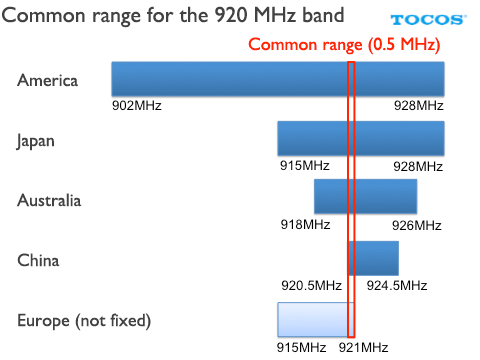
Some explain that there is a plan to change from the currently used 800 MHz band in Europe to the 920 MHz band and that the 920 MHz band will be the global frequency, if the plan is realized. However, this explanation leads to misunderstandings. To be accurate, there is a band that can be used as a common band in some countries. For example, the assignment of the 900 MHz band in North America is 26 MHz between 920 MHz and 928 MHZ, while it is 13 MHz between 915 MHz and 928 MHz in Japan. Thus, the range common to both areas is the half. The products with Japanese specification cannot transmit the channels of upper half (902 MHz ~ 915 MHz) in the U.S. In Australia, the assignment is narrower and it is 8MHz between 918 MHz and 926 MHz. Therefore, the common band to the three countries is 8 MHs between 918 MHz and 926 MHz.
Currently, the Sub-Giga band is assigned to 800 MHz in Europe and it is not assigned to the 920 MHz band. Although assigning of the Sub-Giga band to 920 MHz is discussed in Europe, changing to 920 MHz band (900 MHz ~ 928 MHz) assigned to the Global System for Mobile Communications (GSM) is not easy, and if it is assigned, it will be 6 MHz between 915 MHz and 921 MHz. If China, where assigning is for 4MHz between 920.5 MHz and 924.5 MHz, is added, the band common to these countries will be 1.5 MHz between 920.5 MHz and 921 MHz.
This is the assignment of frequency for Sub-Giga band; however, in Japan, the channel assignment in the 920 MHz band and between 915 MHz and 928 MHz available to sensor network is further limited. As the 920 MHz band is shared with the passive tag system, the range available to sensor network is 8.8 MHz between 920 MHz and 928.8 MHz. Also, the range that can be used as the channel dedicated to sensor network with a maximum output of 20 mW and without license is actually as small as 4.4 MHz between 923.6 MHz and 928 MHz.
Therefore, it is and will be extremely difficult to use the 920 MHz band as the global frequency. Use of the 920 MHz band is allowed only in the countries where the use is permitted and for the limited channels. If you expand your products globally, you will immediately face this issue.
In the case of the 2.4 GHz band
The common frequency band used without wireless license (the ISM Band) is limited to 2.4 GHz. With the advancement in business globalization and the increase in the expansion of products overseas, this band has been popular as the frequency that can be used worldwide. Sufficient band, which is 83.5 MHz between 2400 MHz and 2483.5 MHz, is secured internationally.
Currently, when there is a possibility of using the product worldwide, 2.4 GHz band is the only choice.
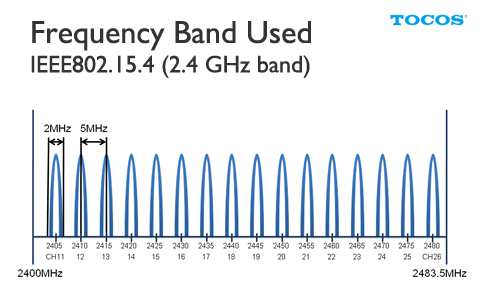
Is there any global standard? (IEEE802.15.4 and IEEE802.15.4g/e)
Answer:
Although the ISM band can be used freely without license, there is an international standard specifying the sensor network communications method respectively for the 920 MHz band and the 2.4 GHz band. However, existence of specification in the international standard does not mean that it can be used all over the world. The global common frequency is limited to the 2.4 GHz band.
As the specifications unique to a company may be abolished someday, adoption of the standard specifications can guarantee the long-term and stable supply of products.
In the case of the 920 MHz band
IEEE802.15.4g/2 is specified as the international standard by the IEEE; however, this is not dedicated to the 920 MHz band and it specifies the standard for all the Sub-Giga bands, including 915 MHz in the U.S, 863 MHz band in Europe, 470 MHz in China and so on.
IEEE802.15.4g/e specifies a lot of channel plans, modulation methods and communication speed, which vary from country to country, and the number of combinations of the parameters is extremely large. It is not easy to support all of these.
As described earlier in this section, IEEE802.15.4g/e is the international standard; however, the frequencies available to each country vary and the 920 MHz band is not always usable all around the world.
In the case of the 2.4 GHz band
IEEE802.15.4 is a standard for establishing a sensor wireless network, conventionally assigning 2.4 GHz for the common use around the world, 915 MHz band as the Sub-Giga band for North America, and 868 MHz band for Europe. As channel 0 to 26 is serially assigned to IEEE802.15.4 / ZigBee, that is, 0ch for 868 MHz band, 1 ~ 10ch for 915 MHz band, and 11 ~ 26ch for 2.4 GHz band, this standard allows simultaneous use of 2.4 GHz and Sub-Giga band. 915 MHz band in Japan is not integrated to IEEE802.15.4 standard and another standard, IEEE802.15.4g is specified.
It has been 10 years since the establishment of IEEE802.15.4 and the major band is currently 2.4 GHz only and the case where Sub-Giga is used is rare in the U.S. and Europe. The reason for this from the marketing standpoint is that Sub-Giga is not the common and global frequency; and the technical reasons are the limitation in the number of terminals stored due to slow communication speed and the difficulty in downsizing of a big antenna.
Can I use these bands to transmit data in a consecutive manner?
Answer:
Continuous transmission of data is permitted for the 2.4 GHz band; however, it is not permitted for the 920 MHz band due to the restriction in communications time and interval.
Sensor network carries out intermittent communications for periodic temperature sensor data measurement or serial data communications such as for accelerometer and vibration gauge. When using the transmission for a remote controller, it may be necessary to send signals serially in a small amount of delay time by pressing a button at a free timing.
Also, starting of the transmission at a free timing is important to send data again or save power. Furthermore, as the limitation to the transmission timing decreases the throughput (communications speed) and deteriorates the latency (delay time), there is a concern over the decrease in the number of terminals that can participate in the network and the overtime of processing time.
2.4 GHz band allows radio interference prevention measures through the serial transmission at a free timing. When using the 920 MHz band, it is difficult to secure the time for taking sufficient measures.
Difference in the method for using radio waves between the 2.4 GHz band and the 920 MHz band
Specified Low Power Wireless whose public use is permitted requires interference prevention measures regardless of the frequency bands. The use method is specified for each frequency band.
- The band assigned to each channel is 2 MHz for the 920 MHz band, which is 40% or less than half of 5 MHz for the 2.4 GHz band. The transmission speed for 920 MHz band is 100 kpbs at the most, which is also less than half of 250 kpbs for the 2.4 GHz band. Therefore, the time for sending the same data amount in the 920 MHz band requires 2.5 times longer than the 2.4 GHz band. When sending packets that require long transmission time, packet sending will not be completed in the case of an occurrence of blockage during transmission. To send 100-byte data, it takes 4 ms in the 2.4 GHz and approximately 10 ms in the 920 MHz band. The 920 MHz band tends to be busy, because the time used by individual terminals is long. Due to these reasons, a strict restriction is set to the carrier sense before sending and the number of sending in the 920 MHz band under the Radio Act. To put it simply, it is the concept of staying quite as long as possible not to bother others. Therefore, there is a limit to the interference prevention measures.
- The 2.4 GHz band characteristically has a large number of users and technologies due to its excellent balance as the wireless radio wave and its user-friendliness. The reason why this band is popular is that the wavelength is 12.5 cm, it is easy to establish a compact and high performance antenna, and that a wide variety of antennae are available in the market. Although it has a straight-going radio wave property in comparison with the 400 MHz band, it is not significantly different from the 920 MHz ad Sub-Giga Hz band. With the current trend for a faster WiFi (wireless LAN), it is expected to shift to the 5 GHz band in the future. Radio waves from microwaves, wireless LAN, and other equipment may be emitted; however, there is no problem to emit excessive radio waves. Thus, there is few communications restriction in the 2.4 GHz band. In other words, if the surrounding area is noisy, you are allowed to continue to talk until you are understood. Also, as the frequency range available to the 2.4 GHz band is wide, the case where all the ranges are occupied is rare and communications are available by selecting any channel that is not busy. Therefore, advanced measures for preventing interference can be implemented.
In the case of the 920 MHz band
Communications specifications for the 920 MHz band are specified by the ARIB STD-T108. This standard specifies the sending quiescent time as the use restriction. As the continuous communications are not allowed for the 920 MHz band, sending quiescent time should be inserted for the communications in this band. Therefore, even if there is no radio wave interference, transmission at a free timing is not possible due to this restriction. As the restricted items differ from channel to channel, the control becomes complex. Carrier sense time is defined with two patterns, namely, 128us or over and 5ms or over, and the serial sending time, sending time and quiescent time permitted per hour, also differ between the two patterns. Control software development for ensuring transmission in accordance with the low will be more complex. Furthermore, delay time for a network with many terminals becomes longer and this will increase the likelihood of congestion.
In the case of the 2.4 GHz band
Communications specifications for the 2.4 GHz band are specified by the ARIB STD-T66. As the standard does not specify the sending quiescent time, sending can be started at a free timing and there is no restriction on the serial communications. As there is no concern over the restriction items due to complex specification, extremely simple control is available. Communications with less delay time (low latency) are also available.
As the time for freely executing data re-sending, changing of channels used, and other appropriate settings can be secured, you can implement interference prevention measures.
TOCOS Channel Agility (Interference avoidance algorithm)
Is it possible to make the antenna size smaller?
Answer:
You can downsize the antenna for the 2.4 GHz band to half the size of that for 920 MHz band.
It is ideal for an antenna to be small and maintain high performance. Particularly, there is a strong need for downsizing of the device for sensor network and small antenna is must.
The antenna length is determined by the wavelength. The wavelength is the inverse number of frequency. Therefore, the lower the radio wave frequency is, the longer the wavelength and the bigger the antenna become. The wavelength of 2.4 GHz is 12.5 cm and the wavelength of 920 MHz is approximately 32.6 cm, which means that the wavelength of 920 MHz is 2.6 times longer than that of 2.4 GHz. For example, when you design a small whip antenna with the length one fourth (1/4λ) of the wavelength, the length is approximately 3 cm for the 2.4 GHz and approximately 8 cm for 920 MHz. An 8-cm antenna is a little too big for a small sensor, small wireless tag and other small devices.
If you forcibly reduce the size of an antenna, performance will be sacrificed with low gain and poor communications performance. When comparing antennae with the same size and the same design, 2.4 GHz has a higher gain than 920 MHz. As the link budget is added both for sending and for receiving with an antenna, the gap of gain will double. In other words, margin for 920 MHz in the path-loss calculation is greater than that for 2.4 GHz by 8.33 dB; however, if the antenna gain decreases by 4.2 dB, the margin for 920 MHz will be offset.
with a gain of 2 dBi
Left: for the 920 MHz band / Right: for the 2.4GHz band
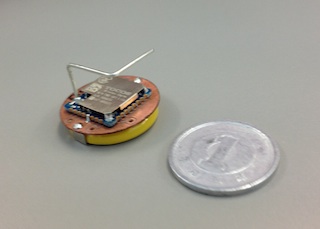 Example of an ultra-small antenna
Example of an ultra-small antenna for the 2.4 GHz band
Ultra-small Active RFID (2.4 GHz band)
As mentioned above, when downsizing of a device is necessary, 2.4 GHz band, which can make the antenna with the same gain smaller than 920 MHz band, will be advantageous. When there is no restriction on the device size, both the 920 MHz band and the 24 GHz band will be an option.
2.4 GHs band small antenna
Ultra-small ZigBee / IEEE802.15.4 Module (smaller than one 1-yen coin)
Are there many antenna selections?
As the 2.4 GHz band has been widely used in the world for WiFi, Bluetooth, etc., various antennae according to the installation conditions and usage are available in the market and the advantage of the band is a wide variety of selections in terms of function, performance and price. With a directional antenna, you can establish a restriction on the radio wave transmission area, and with a high-gain antenna, you can expand the emitting distance.
On the other hand, the antenna selections for the 920 MHz band are significantly limited in comparison with the 2.4 GHz band. Particularly, as a directional antenna in the 920 MHz band has a long frequency, the size of high-gain antenna becomes huge and the installation place is significantly limited.
A wide variety of 2.4 GHz band antennae
Is it possible to use for a long period of time with batteries?
Answer:
Answer: Communications in the 2.4 GHz band consume less energy than the 910 MHz band.
Batteries are consumed during standby, start-up, network connection, and communications time. Consumption during standby and start up varies depending on the wireless module performance. Consumption during network connection varies depending on the communications protocol and the consumption during communications is determined by the communications speed.
The faster the data transmission speed is, the shorter the sending time becomes. When comparing 920 MHz band with the 2.4 GHz band, the communications speed in the 920 MHz band is slower than the 2.4 GHz band and this is disadvantageous. IEEE802.15.4 standard specifies the communications speed of 2.4 GHz to 250 kbps. This is the necessary communications speed to enable many terminals to execute communications every few seconds. IEEE802.15.4g covering the 920 MHz band also specifies several communications speed; however, the fastest communications speed in Japan is currently 100 kbps. Therefore, if the communications speed in the 2.4 GHz band is compared to the fastest speed in the 920 MHz band, it is 2.5 times faster than the 920 MHz band, which is a great advantage in saving power. Although Sub-Giga bands with low frequency are suitable for an operation at a low speed, increase in the speed sacrifices the receiving sensitivity.
Power consumption, receiving sensitivity, and balance in the number of terminals to be stored in the 2.4 GHz in accordance with IEEE802.15.4 are optimized for sensor network. For your information, WiFi and Bluetooth have the fast communications speed after being connected to the network; however, the network connection takes time and batteries are consumed during the connection time.
A 920 MHz band wireless module increases the output to compensate the antenna gain loss for using a small antenna and the loss of receiving sensitivity due to higher communications speed, which conflicts with power conservation. If the radio wave transmission performance of a 920 MHz band wireless module is better than a 2.4 GHz wireless module by 8.33 dB, an output of 1 mW in a 920 MHz band is supposed to be equal to the communications distance by a 2.4 MHz module of 10 mW; however, the actual result is different. Conversely, 920 MHz band wireless modules increase the output to 20 mW in the real situation. Therefore, 920 MHz band wireless modules have disadvantage in terms of power conservation.
Battery life of the super-low power consumption wireless module
Ultra-small ZigBee / IEEE802.15.4 Module (smaller than one 1-yen coin)
Is it possible to establish a large-scale network?
Answer:
The 2.4 GHz band can establish a network of a larger scale than the 920 MHz band.
Explanation:
If the frequency is higher, a network can transmit more information. Communications in the 2.4 GHz band can be done in a shorter period of time than the 920 MHz band. Also, as the 2.4 GHz band has no restriction on the sending quiescent time, unlike the 920 MHz band, great amount of communications are allowed in a certain period of time. As a result, the 2.4 GHz band can establish a larger-scale network than the 920 MHz band. If the 920 MHz band with a small capacity has an increased number of terminals, congestion (overcapacity) can easily occur and communication will be disabled even when the radio waves are active. This is called “Packet Jam” phenomenon. Therefore, the 2.4 GHz band is the best solution for smart meters, HEMS, BEMS, M2M, IoT, and other systems with many terminals.
Is the 2.4 GHz band subject to interference?
Answer:
When using wireless, radio wave interference always occurs regardless of frequency. Generally, if the number of wireless devices transmitting the same frequency radio waves increases, they will be more subject to the interference. Furthermore, interfering radio waves are emitted not only by wireless devices but also by other various machines and equipment. Therefore, the important point is presence or absence of the effective interference avoidance measures.
Explanation:
IEEE802.15.4 data packets are extremely small (one channel width: 2 MHz, up to 127 bytes), the communications speed is fast (250 kbps), and the communication time is instantaneous and up to 0.004 seconds (4/1000 seconds). Therefore, it is designed to have extremely small possibility of packet collisions. The maximum packet size in the 920 MHs band specified by IEEE802.15.4g/e is up to 2048 bytes, and it takes 0.164 seconds at a communications speed of 100 kbps and 0.328 seconds at a communications speed of 50 kbps. If many terminals of this kind with long communications and high communications occupancy participate in a network, the 920 MHz band is more likely to have interference.
Although WiFi and Bluetooth use the same band in the2.4 GHz band under IEEE802.15.4, the modulation methods are different and they can coexist in the same frequency. If the noise level is extremely high, packet errors can easily occur; however, the errors can be recovered by re-sending the packets.
Microwave ovens also us the 2.4 GHz band; however, they are intended for cooking in a housing with a shield and the radio waves are not leaked to a wide range of the outside. Furthermore, they do not continue to emit radio waves all through the cooking time and small packets of IEEE802.15.4 can go through. IEEE802.15.4 has adopted DSSS (spread spectrum) with high noise elimination performance in the narrow band communications. On the other hand, as WiFi uses a wide radio wave band (20 MHz) for one channel and the packet size is big, it is easily influenced near a microwave oven.
The use of 920 MHz band was started not so long ago and it is natural that most of other wireless devices do not use this band at present. However, once various wireless devices start using this band, coexistence with other systems will become an issue. The 920 MHz band has a slower communications speed, larger maximum packet size than the 2.4 GHz band and sending quiescent time is specified. Therefore, the 920 MHz band tends to have more frequent occurrence of interference than the 2.4 GHz band in the highly frequent communications and communications between many wireless nodes. If the 920 MHz band is fully operated, it is concerned that the issue of interference will be more serious than the 2.4 GHz band.
On the other hand, although WiFi with a wide range of use in the 2.4 GHz band can easily have interferences, IEEE802.15.4 for narrow band communications is the communication specifications that have a small possibility of packet jam, thanks to small packets, low susceptibility to multi-path, and high noise resistance. Furthermore, IEEE802.11ac allowing faster communications has been established for WiFi and WiFi is shifting to the5 GHz band, which alleviates the jam in the 2.4 GHz band.
Basically, a higher frequency has a larger the communications capacity which allows configuration of a large-scale network. A higher frequency can store more terminals in a certain range. In other words, the likelihood of having interference and congestion is higher in the 920 MHz band than in the 2.4 GHz band. As the use of 900 MHz band has been already permitted in the U.S., Australia, and Canada, smart meters have been introduced in the U.S. (California), in Australia (Victoria) and in other areas; however, radio wave interferences have been reported and discussed. The 900 MHz band in a crowded area in an urban city does not have a band allowance sufficient for the communications by HEMS equipment in addition to the smart meters. As mentioned earlier in this chapter, the 900 MHz band in the U.S. has a far more wide area assignment than Japan where the assignment is for 26 MHz between 920 MHz and 928 MHz.
Is there any interference prevention measure?
The 2.4 GHz band has a smaller packet size than the 920 MHz band and this is an advantage. Packets with a short communication time in the 2.4 GHz band have a smaller chance of collisions than the 920 MHz band. As the 2.4 GHz band has no sending limit and quiescent time that the 920 MHz band has, it can correct errors by immediately sending the data again. Furthermore, the 2.4 GHz band has a faster communications speed than in the 920 MHz band and this can secure more opportunities of re-sending. In other words, a more secure interference avoidance measure with communications protocols can be established in the 2.4 GHz band than in the 920 MHz band.
TOCOS Channel Agility (Interference avoidance algorithm)
Which has a longer signal range?
Answer:
Signal range depends more on the difference in wireless module performance then on the frequency. The answer to the question, which has a longer signal range, differs depending on the environment; however, for sensor network, a wireless module with great link budget has a longer signal range as a rule. Although the 950 MHz band was available in Japan, there was no wireless module with a longer signal range than the 2.4 GHz band.
According to a physics textbook, a signal range at a lower frequency becomes longer with a better diffraction in the case of the same output in an ideal free space. Therefore, it means that the 920 MHz band has a longer signal range and a better diffraction than the 2.4 GHz band. This is also described in an advertisement for a 920 MHz band wireless module. The diffraction of the 920 MHz band is certainly better than the 2.4 GHz band and the both bands are classified in UHF (Ultra High Frequency) between 300 MHz and 3000 MHz, which has a strong straight-going performance in terms of a general radio wave scale. For example, UHF has a low diffraction than VHF (Very High Frequency) between 30 MHz and 300 MHz and it is difficult for UHF to penetrate in mountain areas. Therefore, the diffraction of 920 MHz is not as good as expected. If you expect the radio wave diffraction in the UHF band, 300 MHz or 400 MHz with a longer wavelength than the 920 MHz band is more advantageous. For long-distance communications such as space communications, microwaves with much shorter wavelength than the 2.4 GHz band are used. In this case, the band with higher frequency will be able to perform long-distance communications.
Communications performance is expressed by link budget, which is a numerical value. Link budget is: (sending output + antenna sending gain) – receiving sensitivity. The greater the link budget is, the longer the signal range becomes.
First, we explain the data which is the evidence for a better radio wave propagation of the 920 MHz band than the 2.4 GHz band. The graph below shows the comparison between the theoretical values (path-loss) of the signal range of the 920 MHz band and the 2.4 GHz band in a free space. For example, with a link budget of 100 dB, the signal range is 2,594 m for 920 MHz and 995 M for 2.4 GHz. With the same link budget, the signal range of 920 MHz is approximately 2.6 times longer than the 2.4 GHz according to the calculation. In terms of a decibel value, if the link budget of 920 MHZ is smaller than the 2.4 GHz by 8.33 dB, communications will be available for the same distance. In other words, 920 MHz has a smaller attenuation than 2.4 GHz by 8.33 dB in a free space.
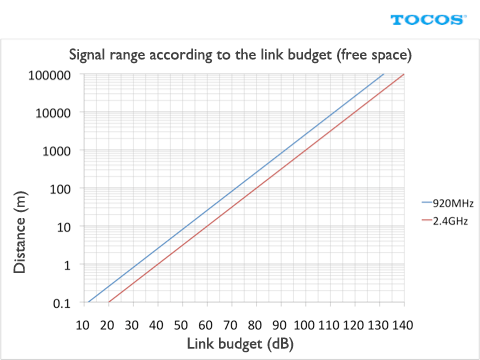
However, it is rare that wireless equipment is used in an ideal free space in a real situation and the operation environment differs from each other. Therefore, the answer to the question, which has a longer signal range, 2.4 GHz or 920 MHz, also varies from situation to situation. The height of antenna, conditions of an obstacle and other relevant factors change the radio wave path in a complex manner. Any frequency is not effective at a place where radio waves cannot penetrate, and reflection can be more effective than the diffraction to penetrate radio waves in some cases. Particularly inside of a room, reflection at walls, floor, and ceiling is effective.
The height of an antenna is particularly important and it is a major element which affects the signal range. The figure below shows radio wave propagation. Radio waves spread and propagate in a spheroidal shape to the line between the antennae. This space is called Fresnel zone. The comparison of signal range between 2.4 GHz and 920 MHz described earlier is under the condition where the Fresnel zone is completely floating in the air without any obstacles. If a part of the Fresnel zone has an obstacle, it will affect the signal range.
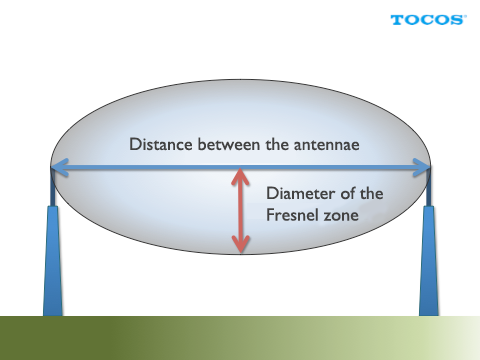
The following graph shows how high the antennae should be to secure the Fresnel zone. When the distance between the antennae is 100 m, the required antenna height is 1.8 m for 2.4 GHz and 2.9 m for 920 Mhz. When it is 1000m, the required antenna height is 5.6 m for 2.4 GHz and 9m for 920 MHz. When it is 3000m, it is 9.7 m for 2.4 GHz and 15.6 m for 920 MHz. In other words, the required antenna height for 920 MHz is 1.6 times higher than that for 2.4 GHz.
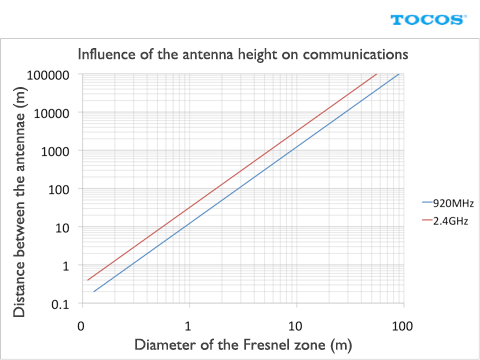
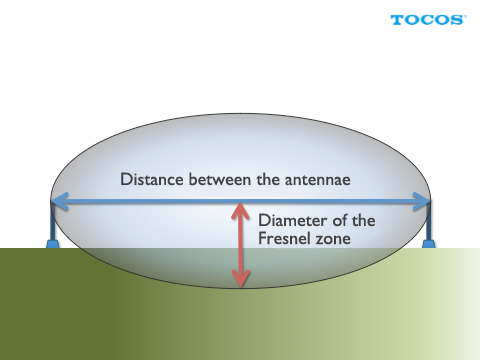
The 2.4 GHz band with stronger straight-going performance can secure the Fresnel zone with lower antennae than the 920 MHz band.
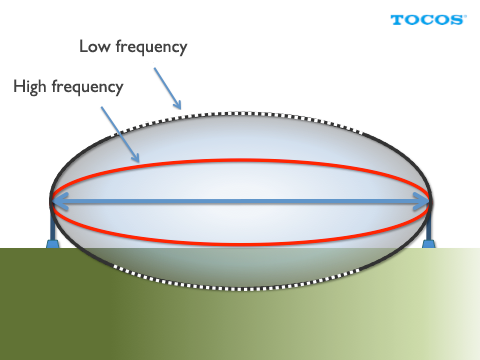
When the antennae are low and nothing exists between the antennae, the ground becomes a huge obstacle.
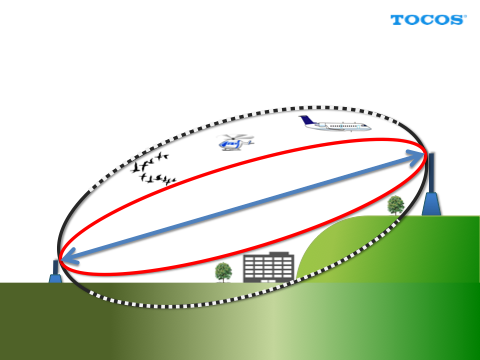
As the 920 MHz band has a larger diameter of the Fresnel zone than the 2.4 GHz band, the 920 MHz band has a wider range which is affected by the obstacles. Therefore, antennae need to be installed on a sufficiently high place like a mobile base station and communications should be executed with high output to exert the effect of Sub-Giga long-distance communications, which is a rare case for the use in sensor network.
Generally, it is said that good communications will be achieved by securing 60% of the diameter of Fresnel zone. The following graph shows the relationship between 60% of the diameter of Fresnel zone and the distance between antennae.
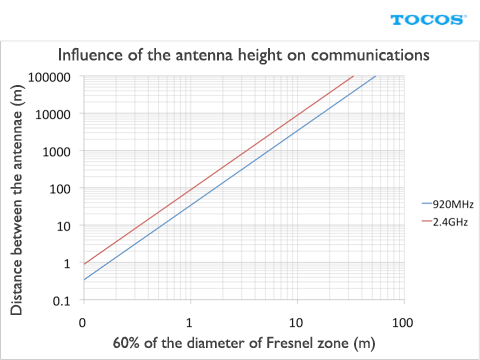
As the height of a normal office desk is 70 cm, it is assumed that a wireless terminal is placed at this height. The distance to secure 60% of the Fresnel zone at the height of 70 cm is approximately 44.5 m for 2.4 GHz and approximately 17 m for 920 MHz. The distance for 2.4 GHz is 2.6 times longer than 920 MHz.
When it is assumed that a person carries a wireless terminal at the height of his/her breast, the height is approximately 1 m. The distance to secure 60% of the Fresnel zone at the height of 1 m is approximately 90 m for 2.4 GHz and approximately 40 m for 920 MHz. The distance for 2.4 GHz is 2.25 times longer than 920 MHz.
If the actual use conditions are assumed for sensor network as shown above, the 2.4 GHz band has an advantage in securing the Fresnel zone over the 920 MHz band.
When wireless terminals are used indoor, the space is closed by walls, floor and ceiling and there is no room for radio waves to diffract. Therefore, the most important element for radio waves to penetrate in a sensor network is not the diffraction and it is the permeability.
The most important point to improve the permeability and increase the signal range is the performance of wireless module. Communications performance of a wireless module is expressed by the sending output and the receiving sensitivity, which is called link budget. The greater the value is, the higher the radio wave permeability becomes. Radio waves with a great link budget can penetrate obstacles and reach the target. Currently available 920 MHz wireless modules and 2.4 GHz wireless modules have the link budget of around 100 dB. If the performance as specified in the specifications is obtained, the signal range at line of sight will be 1 km or longer by the path-loss calculation. Thus, both of the two bands cause no inconvenience in terms of the permeability. However, the influence of the Fresnel zone and the attenuation by other obstacles should be considered when choosing the band. The 920 MHz band has smaller attenuation in a free space than the 2.4 GHz band; however, the attenuation can be smaller in the 2.4 GHz band according to the material of obstacles. If the case that the radio wave propagation environment is poor, the 920 MHz band will have rapid attenuation.
Various wireless modules with different performance exist in the world. Wireless modules with the same specifications can have significantly different signal range. Even if the same frequency is used, some wireless modules have a long signal range and some don’t. This is due to the difference in the ability of link budget between wireless modules. Some say that 2.4GHz does not have a long signal range and this is not cause by the frequency but this is caused by a small link budget for the wireless module used. As the gain of a 920 MHz band wireless module equipped with a compact antenna is small, this wireless module also has a poor signal range.
As described above, some factors affect the radio wave propagation for long-distance communications. Although the loss in the 920 MHz band in a free space is smaller than the 2.4 GHz band, the 2.4 GHz band is often advantageous when practical antenna size and antenna height are considered for the use in sensor network. The 2.4 GHz band, whose wavelength is short, is more advantageous than the 920 MHz band when extending the signal range by using directional and high-gain antennae, restricting the propagation area by using directional antennae, and narrowing the range affected by noise.
Signal range of the 2.4 GHz band wireless modules
Long Signal Range ZigBee/IEEE802.15.4 wireless module
Summary
Answer:
For HEMS, BEMS, FEMS, CEMS, M2M, IoT and other sensor network equipment, the 2.4 GHz band has more advantages than the 920 MHz band. The advantages of the 2.4 GHz band over the 920 MHz band are: the capacity for global product development; the compact antenna allowing downsizing of products; the low communications speed allowing low-latency communications; and the absence of sending quiescent time, which facilitates the interference avoidance measures.
Congestion in the 2.4 GHz band due to WiFi, an issue for the 2.4 GHz band, will be alleviated rapidly in the future because IEEE802.11ac, the gigabit wireless LAN standard for the latest high-speed communications, uses the 5 GHz band.
As for the merit and demerit in the diffraction, it is assumed that sensor network devices both in the 2.4 GHz band and in the 920 MHz band use multiple-hop communications. Therefore, communication range can be secured by a repeater and a slight difference in the propagation property does not lead to a big problem for the system.
We have compared various points between the 2.4 GHz band and the 920 MHz band. As a summary, we can say that the2.4 GHz band may have been named as “Platinum Band”, if the 920 MHz band existed earlier and the 2.4 GHz band became available as a new option.
IEEE802.1.5.4 Wireless Module
As we offer IEEE802.15.4 Wireless Module TOCOS Wireless Engine, which is the best solution for establishing Wireless Sensor Network of low latency, super-low power consumption and with long-distance communications, we can help you in simplifying of communications function development and early market entry of your equipment related to sensor network.
For the usage example of TOCOS Wireless Engine, please refer to Usage.
Evaluation and Development of IEEE802.1.5.4Wireless Module
We offer Sensor Network Evaluation Kit for wireless monitoring of temperature and humidity applicable to sensor network and Wireless Sensor which operates without batteries and supports Energy Harvesting Technology, as an evaluation and development tool.
Related Products
- Sensor Network Evaluation Kit
- Ultra-small ZigBee/IEEE802.15.4 Wireless Module
- Super-low Power Consumption ZigBee/IEEE802.15.4 Module
- Long Signal Range ZigBee/IEEE802.15.4 Module
- ZigBee/IEEE802.15.4 Evaluation and Development Kit
Related Information
Wireless Products
- Overview
- Wireless Products Overview
- Wireless Engine
- TWE Lite DIP
- TWE-Lite
- TWE-REGULAR
- TWE-STRONG
- Software
- ToCoNet
- TWE-ZERO
- Evaluation, Development
- Evaluation & Development Kit
- Sensor Network Evaluation Kit
- Antenna
- Avaliable Antennae
Technical Information
- RFID
- 920MHz_vs_24
- IEEE802.15.4
- Protocol Stack
- ZigBee
- Wireless Sensor Networks
- Energy Harvesting Technology
- M2M Wireless Communications
- HEMS / BEMS / FEMS / CEMS
- Internet of Things

